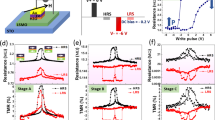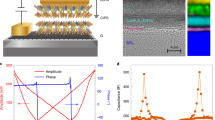Abstract
The range of recently discovered phenomena in complex oxide heterostructures, made possible owing to advances in fabrication techniques, promise new functionalities and device concepts1,2,3. One issue that has received attention is the bistable electrical modulation of conductivity in ferroelectric tunnel junctions4,5,6 (FTJs) in response to a ferroelectric polarization of the tunnelling barrier, a phenomenon known as the tunnelling electroresistance (TER) effect7,8,9,10. Ferroelectric tunnel junctions with ferromagnetic electrodes allow ferroelectric control of the tunnelling spin polarization through the magnetoelectric coupling at the ferromagnet/ferroelectric interface11,12,13,14,15,16,17. Here we demonstrate a significant enhancement of TER due to a ferroelectrically induced phase transition at a magnetic complex oxide interface. Ferroelectric tunnel junctions consisting of BaTiO3 tunnelling barriers and La0.7Sr0.3MnO3 electrodes exhibit a TER enhanced by up to ~ 10,000% by a nanometre-thick La0.5Ca0.5MnO3 interlayer inserted at one of the interfaces. The observed phenomenon originates from the metal-to-insulator phase transition in La0.5Ca0.5MnO3, driven by the modulation of carrier density through ferroelectric polarization switching. Electrical, ferroelectric and magnetoresistive measurements combined with first-principles calculations provide evidence for a magnetoelectric origin of the enhanced TER, and indicate the presence of defect-mediated conduction in the FTJs. The effect is robust and may serve as a viable route for electronic and spintronic applications.
This is a preview of subscription content, access via your institution
Access options
Subscribe to this journal
Receive 12 print issues and online access
$259.00 per year
only $21.58 per issue
Buy this article
- Purchase on Springer Link
- Instant access to full article PDF
Prices may be subject to local taxes which are calculated during checkout




Similar content being viewed by others
References
Mannhart, J. & Schlom, D. G. Oxide interfaces—An opportunity for electronics. Science 327, 1607–1611 (2010).
Zubko, P., Gariglio, S., Gabay, M., Ghosez, P. & Triscone, J-M. Interface physics in complex oxide heterostructures. Ann. Rev. Condens. Matter Phys. 2, 141–165 (2011).
Hwang, H. Y. et al. Emergent phenomena at oxide interfaces. Nature Mater. 11, 103–113 (2012).
Zhuravlev, M. Y., Sabirianov, R. F., Jaswal, S. S. & Tsymbal, E. Y. Giant electroresistance in ferroelectric tunnel junctions. Phys. Rev. Lett. 94, 246802 (2005).
Kohlstedt, H., Pertsev, N. A., Rodriguez Contreras, J. & Waser, R. Theoretical current–voltage characteristics of ferroelectric tunnel junctions. Phys. Rev. B 72, 125341 (2005).
Tsymbal, E. Y. & Kohlstedt, H. Tunneling across a ferroelectric. Science 313, 181–183 (2006).
Garcia, V. et al. Giant tunnel electroresistance for non-destructive readout of ferroelectric states. Nature 460, 81–84 (2009).
Gruverman, A. et al. Tunneling electroresistance effect in ferroelectric tunnel junctions at the nanoscale. Nano Lett. 9, 3539–3543 (2009).
Maksymovych, P. et al. Polarization control of electron tunneling into ferroelectric surfaces. Science 324, 1421–1425 (2009).
Chanthbouala, A. et al. Solid-state memories based on ferroelectric tunnel junctions. Nature Nanotech. 7, 101–104 (2012).
Zhuravlev, M. Y., Jaswal, S. S., Tsymbal, E. Y. & Sabirianov, R. F. Ferroelectric switch for spin injection. Appl. Phys. Lett. 87, 222114 (2005).
Velev, J. P. et al. Magnetic tunnel junctions with ferroelectric barriers: prediction of four resistance states from first principles. Nano Lett. 9, 427–432 (2009).
Garcia, V. et al. Ferroelectric control of spin polarization. Science 327, 1106–1110 (2010).
Hambe, M. et al. Crossing an interface: Ferroelectric control of tunnel currents in magnetic complex oxide heterostructures. Adv. Funct. Mater. 20, 2436–2441 (2010).
Yin, Y. W. et al. Coexistence of tunneling magnetoresistance and electroresistance at room temperature in La0.7Sr0.3MnO3/(Ba,Sr)TiO3/La0.7Sr0.3MnO3 multiferroic tunnel junctions. J. Appl. Phys. 109, 07D915 (2011).
Pantel, D., Goetze, S., Hesse, D. & Alexe, M. Reversible electrical switching of spin polarization in multiferroic tunnel junctions. Nature Mater. 11, 289–293 (2012).
Yin, Y. W. et al. Multiferroic tunnel junctions. Front. Phys. 7, 380–385 (2012).
Tsymbal, E. Y., Gruverman, A., Garcia, V., Bibes, M. & Barthélémy, A. Ferroelectric and multiferroic tunnel junctions. Mater. Res. Soc. Bull. 37, 138–143 (2012).
Esaki, L., Laibowitz, R. B. & Stiles, P. J. Polar switch. IBM Tech. Discl. Bull. 13, 2161 (1971).
Gajek, M. et al. Tunnel junctions with multiferroic barriers. Nature Mater. 6, 296–302 (2007).
Duan, C-G., Jaswal, S. S. & Tsymbal, E. Y. Predicted magnetoelectric effect in Fe/BaTiO3 multilayers: Ferroelectric control of magnetism. Phys. Rev. Lett. 97, 047201 (2006).
Niranjan, M. K., Burton, J. D., Velev, J. P., Jaswal, S. S. & Tsymbal, E. Y. Magnetoelectric effect at the SrRuO3/BaTiO3 (001) interface: An ab initio study. Appl. Phys. Lett. 95, 052501 (2009).
Valencia, S. et al. Interface-induced room-temperature multiferroicity in BaTiO3 . Nature Mater. 10, 753–758 (2011).
Dagotto, E., Hotta, T. & Moreo, A. Colossal magnetoresistant materials: The key role of phase separation. Phys. Rep. 344, 1–153 (2001).
Burton, J. D. & Tsymbal, E. Y. Prediction of electrically induced magnetic reconstruction at the manganite/ferroelectric interface. Phys. Rev. B 80, 174406 (2009).
Molegraaf, H. J. A. et al. Magnetoelectric effects in complex oxides with competing ground states. Adv. Mater. 21, 3470–3474 (2009).
Vaz, C. A. F. et al. Origin of the magnetoelectric coupling effect in Pb(Zr0.2Ti0.8)O3/La0.8Sr0.2MnO3 multiferroic heterostructures. Phys. Rev. Lett. 104, 127202 (2010).
Burton, J. D. & Tsymbal, E. Y. Giant tunneling electroresistance effect driven by an electrically controlled spin valve at a complex oxide interface. Phys. Rev. Lett. 106, 157203 (2011).
Chang, H. J. et al. Atomically resolved mapping of polarization and electric fields across ferroelectric/oxide interfaces by Z-contrast imaging. Adv. Mater. 23, 2474–2479 (2011).
Schiffer, P., Ramirez, A. P., Bao, W. & Cheong, S. W. Low temperature magnetoresistance and the magnetic phase diagram of La1−xCaxMnO3 . Phys. Rev. Lett. 75, 3336 (1995).
Glazman, L. I. & Matveev, K. A. Inelastic tunneling through thin amorphous films. Sov. Phys. JETP 67, 1276–1282 (1988).
Giannozzi, P. et al. QUANTUM ESPRESSO: A modular and open-source software project for quantum simulations of materials. J. Phys. Condens. Matter 21, 395502 (2009).
Acknowledgements
The work at Pennsylvania State University (PSU) was supported in part by the DOE (Grant No. DE-FG02-08ER4653) and the NSF (Grant No. DMR-1207474). The PSU NSF MRSEC seed grant and NNIN Nanofabrication facilities are acknowledged. The work at USTC was supported by NBRP-2012CB922003 and NSFC. The work at the University of Nebraska-Lincoln (UNL) was supported by NSF MRSEC (Grant No. DMR-0820521) and NSF EPSCoR (Grant No. EPS-1010674). Computations were performed at the UNL Holland Computing Center. The work at ORNL was supported by the Materials Science and Engineering Division of the US DOE.
Author information
Authors and Affiliations
Contributions
E.Y.T. and J.D.B. predicted the magnetoelectrically induced TER effect and stimulated the experimental studies. Q.L. designed and supervised the experiment. Y.W.Y. fabricated samples and performed transport measurements. Q.L., Y.W.Y. and X.G.L. analysed the data. Y-M.K. and A.Y.B. carried out STEM and EELS measurements in the laboratory led by S.J.P. S.M.Y. performed PFM measurements under the supervision of T.W.N. A.G. assisted in analysing the PFM data. J.D.B. carried out theoretical calculations under the supervision of E.Y.T. Q.L., E.Y.T., Y.W.Y. and J.D.B. wrote the manuscript. All authors contributed to the refinement of the manuscript.
Corresponding authors
Ethics declarations
Competing interests
The authors declare no competing financial interests.
Supplementary information
Supplementary Information
Supplementary Information (PDF 810 kb)
Rights and permissions
About this article
Cite this article
Yin, Y., Burton, J., Kim, YM. et al. Enhanced tunnelling electroresistance effect due to a ferroelectrically induced phase transition at a magnetic complex oxide interface. Nature Mater 12, 397–402 (2013). https://doi.org/10.1038/nmat3564
Received:
Accepted:
Published:
Issue Date:
DOI: https://doi.org/10.1038/nmat3564
This article is cited by
-
Greatly enhanced tunneling electroresistance in ferroelectric tunnel junctions with a double barrier design
npj Computational Materials (2023)
-
Anomalous ferroelectric retention at cryogenic temperature
Science China Materials (2023)
-
Integration of resonant band with asymmetry in ferroelectric tunnel junctions
npj Computational Materials (2022)
-
Direct visualization and control of SrOx segregation on semiconducting Nb doped SrTiO3 (100) surface
Journal of the Korean Physical Society (2022)
-
Non-volatile optical switch of resistance in photoferroelectric tunnel junctions
Nature Communications (2021)



